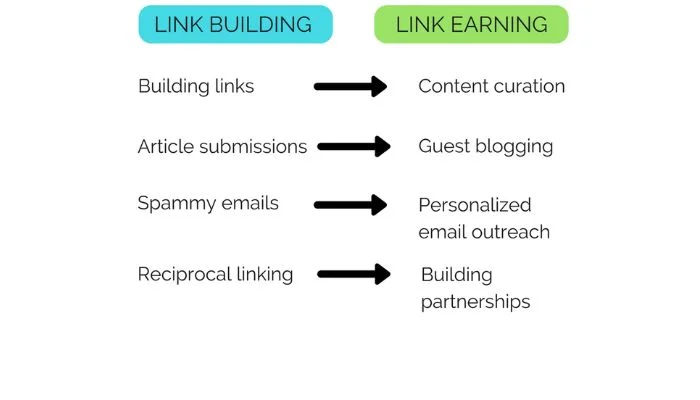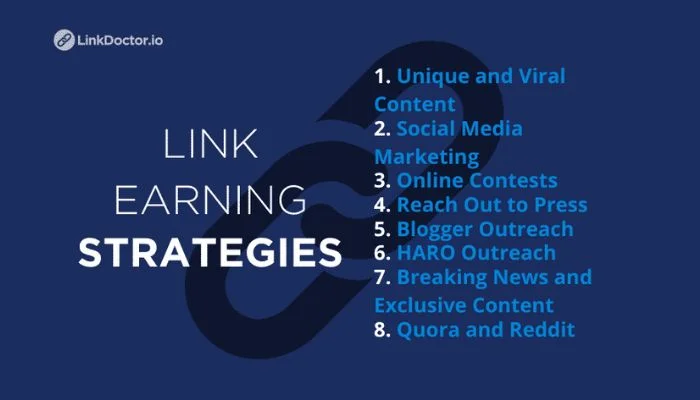Transitioning from Link Building to Link Earning: A Beginner's Guide

The world of SEO is forever changing and it can be difficult to stay abreast of the strategies we need for success. Link building is a popular tactic used by marketers in order to generate high-quality backlinks, but that’s no longer enough. Now more than ever, companies must focus on earning authoritative links naturally through unpaid means; this practice has been labeled link earning.
Through the development of organic relationships such as outreach campaigns, content creation initiatives, and industry affiliations, sites develop higher-quality and more sustainable link profiles which helps them continue to climb up in SERP rankings long after they acquire new links.
This beginner's guide approaches transitioning from traditional link building tactics into habitual link earning practices from start to finish: an introduction outlining its importance, understanding the current link building landscape, steps to help you move from link building to earning backlinks naturally, and provides successful strategies and insight into staying ahead of the game.
Traditional link building strategies
Link building encompasses the strategies used to build high quality links from external websites.
Traditional link building strategies include techniques such as submitting articles and directories, creating content networks or link farms, exchanging links with partner sites, securing links, forum/blog comment spamming, and more.
The focus here was traditionally on quantity over quality -- which wasn't always effective for SEO results.
Additionally, these manipulative tactics caused many unethical practices that left users with a poor experience and Google penalized those sites for poor quality and spammy links.
Focus on quantity over quality
Traditionally, most link building approaches focused solely on maximizing the number of links to gain from any given source. Unfortunately, what often resulted was a shallow approach with black-hat tactics such as guest posting for payment and mass-linking syndication that selfishly ignored webspam and other ranking factors.
Ultimately, this strategy concluded in focusing on quantity over quality — an unsustainable tactic that would ultimately result in penalization and decreased rankings due to web spam violations.
It’s for this reason it’s important to move beyond broken strategies employed by those worried only about link quantity towards strategies stressed at creating meaningful relationships with talented people through shining examples of well-crafted content marketing pieces shared online.
Risks associated with spammy or low-quality links
Link building, while once prioritizing a quantity over quality approach, has become riskier in recent years. Search engine algorithms now prioritize the use of “earned” links versus low-quality ones like article directories and comments sections, introducing penalties for sites using spammy or low-quality techniques.
Furthermore, Google introduced penalty principles related to bad link practices that outline exact infractions where a website might be at risk.
Examples include manipulative link exchange services, deceptive message boards, and clusters of seeding networks made up of spammy links on various platforms including directory Submissions placements & blog comment posting.
To succeed in avoiding being penalized by search engines while practicing safe linking strategies companies must ensure any website they are trying to build links on is authentic and legitimate.
The Concept of Link Earning
Link Earning is an evolved form of link building that focuses on creating relationships and accruing natural, authoritative links through the production of valuable content instead of manipulative tactics.
The idea behind this concept is to obtain backlinks naturally over time rather than attempting a “canal-filled” approach towards building links; think quality over quantity with regard to volume.
Administered carefully and thoughtfully, the result will be increased web traffic as well as organic search visibility due to improved content engagement across multiple channels both on and off your website - ultimately leading to greater business success and growth for your organization or brand.
Importance of creating valuable content
The concept of link earning involves creating quality content that helps to establish influence and trust with readers.
Practically speaking, this means producing engaging content that truly offers value to a website visitor or reader who finds it through an online search.
High-value pieces should have knowledgeable and authoritative information written in an understandable format, backed up but source material as needed, utilizing images to break up sections of text as appropriate.
As the purpose of ranking websites is to provide thoughtful answers to user queries – demonstrating expertise on a particular subject will go a long way in acquiring natural links for SEO purposes.
Establishing authority and trustworthiness
For many organizations, the main objective of link earning is to become an authoritative source of information on specific topics.
This means that you will need to create content that stands out from others in terms of quality and value, allowing users to trust your website and share information with potential customers.
Establishing authority and trustworthiness can be done by crafting evergreen or data-backed content around relevant industry topics; actively engaging on social media channels; leveraging influencer marketing; contributing resources or opinions to industry publications wanting guidance from experienced sources. SEO guidelines should also include well-organized, customer-oriented page structure plus good site GDPR compliance.
Steps to Transition from Link Building to Link Earning

Conducting a link audit
Conducting a link audit is an essential step in transitioning from link building to link earning. It involves analyzing all the links pointing to your website or blog, and looking for any toxic and spammy backlinks that may be harming your SEO.
Through this process, you can find any potentially dangerous connections leading back–such as low quality directories or expired domains–and determine how successful link building campaign attempts have been up until now.
Compiling analytics data helps to get valuable insights on which tactics are worth investing the effort into--and highlight opportunities to earn links based on those insights.
A thorough SEO audit provides an understanding of what works--or doesn't work--for driving more traffic and higher rankings
Removing or disavowing harmful links
Removing or disavowing harmful links is a critical first step when transitioning from link building to link earning. Since decreasing the number of toxic links in your website’s link profile will help you stay off search engine penalty radars, identifying any suspicious or low-quality sites receiving backlinks and removing/disavowing them should typically be your first action point.
This can be achieved using Majestic, Ahrefs, MozLink Explorer, Google Search Console (GSC), etc.
Additionally, manually review user-generated content offerings that may contain external spammy links before deleting them to find if GSC identified any new bad backlinks for those URLs since GSC disavows by the full domain name.
Moreover, constantly monitor old parameters of unhealthy websites still hosting your links with constantly improving brand trustworthiness & search engine reputation security.
Analyzing competitors' link profiles
Analyzing competitors’ backlink profiles is an effective way to research applicable link earning opportunities.
As a first step, define the set of sites or pages which you consider to be your primary competitors in search rankings for relevant keywords.
Then, compare and contrast their respective link profiles to gain insight into where actions may need to be taken on your website in order to build more organic links.
Focus on sources' linked pages by all competitors as well as old sources they may have forgotten about.
This can help pinpoint high-value websites which are currently generating salient traffic and establish new relationships that could leverage previously unknown businesses or technologies tied with successful SEO campaigns.
Identifying valuable link opportunities
Identifying valuable link opportunities can be an essential part of successfully transitioning from link building to link earning. Start by assessing your current links, and perform a competitor backlink analysis so that you know what high-value websites are currently referring traffic to them.
After identifying the competitive landscape, you’re ready to begin looking further for potential referral sources.
Try searching social backlinks sites such as Facebook and Twitter, sites with discussion threads such as ‘FAQs’ and ‘Q&A’ sections or simply Google search for recently related content in your industry.
Lastly, monitor results over time by tracking your own links in tools like MozBar or Ahrefs. If you continue doing this process regularly while avoiding spammy tactics, then it should become easier to stay ahead in your link-building journey.
Strategies for Link Earning

Creating high-quality, informative content
Creating high-quality, informative content is a vital strategy for link building. Content should focus on providing an educational and helpful resource that will provide value to the readers.
The content should be informed by extensive research, including identifying who the target audience is and what type of topics they would find appropriate or useful within their field.
High-quality creative content will pique interest amongst users linking back or sharing it, and ensuring successful link earning efforts in return.
Engaging in outreach and relationship-building
Engaging in outreach and relationship-building is an effective link earning strategy that involves reaching out to influencers, industry bloggers, potential partners, and top authority websites.
This demonstrates transparency and creates trust with others in your field. Outreach can be done through personalized emails, social media comments/posts, blog commenting or content promotion with your target sites. Additionally, creating relationships with others can provide helpful feedback along the way to guide your linking process.
Leveraging social media and influencers
Leveraging social media and influencers is a key part of link earning. Platforms like Facebook, Twitter, Instagram, LinkedIn, and YouTube are great resources for network building, and creating relationships with potential leads/customers and influencers in the industry.
Utilize communities by engaging with other users — start conversations, be helpful in responses, and highlight your content pieces that transition users to your website to build valuable backlinks over time.
Guest blogging and contributing to industry publications
Guest blogging and contributing to industry-relevant online publications are two powerful strategies for earning high-value backlinks that search engines will trust.
They empower brands to reach wider audiences by creating content in partnership with credible sources, strengthening dominance over both SERPs and link acquisition goals.
Remember to focus on providing value through your chosen outlets – readers will be more motivated to click between links when interested in the content created or shared.
Monitoring and Measuring Link Earning Success
Utilizing tools for tracking backlinks
Successfully tracking and measuring backlinks is a key component in making link earning a winning technique.
Utilizing specialized tools such as SEMRush or Ahrefs is essential for optimizing backlinking efforts - these can help save time by quickly analyzing existing URLs, checking anchor texts, seeing results from competitor research, identifying valuable link opportunities, and so much more.
Taking advantage of these will not only track entered links but detect ones formed organically, helping to know which tactics are most successful in organic rankings.
Analyzing referral traffic and conversions
As link earning involves ongoing diligence and improvement, monitoring and measuring success is critical. Analyzing referral traffic and conversions lets you validate the outcome of link activities.
You can calculate ROI (Return on Investment) for each successful link building strategy. This analysis provides useful insights into how well these activities resulted in increased organic reach, engagement or leads.
It also enables you to stay up-to-date with changing trends regarding the quality of referrers and conversions they generate.
Monitoring link growth and diversification
Monitoring link growth and diversification helps to track the success of earned links. This involves keeping an eye on how many linking domains are directing to your website, as well as how diversely they’re spread across categories such as topic relevance and source type.
Ideally, there should be considerable diversity between sources in order for trust & authority to build through natural, organic backlinks on authoritative platforms. Tracking these elements is critical when endeavoring to understand the performance of link earning strategies.
Common Challenges and Tips for Success
Overcoming resistance to change
Overcoming resistance to link earning can sometimes be challenging due to established habits, industry competition for backlinks, and a lack of time or resources.
To help make the switch easier it is important to have the right tools, set specific goals and invest in strategies that are both attainable and effective.
Additionally, stay open-minded—instead of following traditional tactics like paying for links give link earning and other creative methods a chance.
Patience and long-term mindset
Patience and maintaining a long-term mindset are key to success when transitioning from link building to link earning. Link earning is based upon establishing relationships, showcasing credibility through producing quality content and engaging in conversations with your target audience.
This takes time but can have positive – organic and sustainable – improvements on SEO rankings over the long run. As such, move away from focusing solely on immediate wins (quantity) and move towards more comprehensive wins (quality) through patience and well-conceived strategies.
Continuously adapting and evolving link earning strategies
Continuously adapting and evolving link earning strategies is key to gaining sustained success in any industry.
Avoid becoming complacent with one strategy - diversify tactics regularly, research the market for emerging trends, and make sure to steer clear of questionable ethical tactics that could lead to murky long-term results.
Most importantly, keep focused on producing top-notch content as this has been proved time and time again be a consistent factor in achieving measured SEO growth over the long haul.
Conclusion
In conclusion, transitioning from link building to link earning is an imperative strategy for successful SEO growth. Link earning requires creating high-quality and educational content that appeals to the target audience while establishing trustworthiness and strong relationships.
To properly implement this practice, it’s advised to begin with a webpage audit to remove any spammy or low-quality links, identify link opportunities of competitors, reassess your title tags and metadata when creating valuable content, engage in influencer marketing efforts, monitor backlinks for accuracy and referral traffic/conversions ratios with the help of backlink tracking tools.
Above all else try to embrace change by making use of patience their long-term mindset moving forward maintaining success for SEO performances in the future.


.svg)

.jpg)
.jpg)
.jpg)